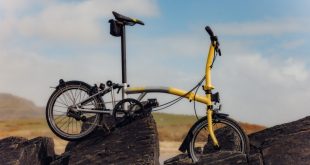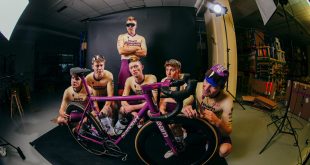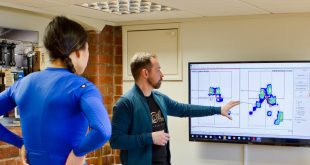Halfords’ decision to call time on two of its retail brands, announced in its April fiscal update, shocked many in the cycle trade. But the superstore chain promised that many of the lessons learnt from Cycle Republic and Bikehut would be filtered into its main stores – including the high-end ranges the stores sold – sparking speculation over whether that meant the firm would be cutting back on its existing ranges, or if it meant Halfords was going to dedicate more space to cycling in its stores.
BikeBiz asks commercial director Paul McClenaghan what the decision really means for Halfords, discusses the firm’s considerable achievement of delivering a profit despite tough trading conditions and talks about how the firm is ramping up its efforts to target the high-end market in a big way…
Are you pleased with Halfords recent results considering the economic climate?
Halfords has continued to perform well, despite the economic backdrop, particularly in our core business, including cycling and car maintenance.
We’ve seen very healthy like-for-like growth in both of those categories. And despite the overall like-for-like decline in the overall business, our active management and what we’ve put into place early on to manage margins and reduce costs has allowed us to deliver growth for the year. It also just re-emphasises how resilient our business is.
Has Halfords size helped it through the recession?
I think our scale, particularly with direct sourcing, has allowed us to both manage our cost base and manage our margin. Also, our relationship with suppliers has allowed us more flexibility than smaller retailers have.
Do you believe the cycle trade is bearing up in general, despite the recession?
I think it is a great time to be in the cycle business. The combination of concerns over the environment, concerns over health and fitness – particularly with children, the lifestyle of cycling and the economy causing people to want to find cheaper ways to commute – these all lead to the industry having a really good start to 2009 and also for the end of last year too.
I think it’s a really good time to be involved in the cycle trade. For us at Halfords, our continued success of Boardman along with some growth from GT and the introductions of the new premium brands we’re looking to bring out as standalones, have given us the opportunity for further growth on the back of the momentum of the whole cycling industry.
Halfords sold one third of bikes purchased in the UK in the last 12 months. Are you planning to increase that proportion?
Our approach has always been to provide good customer service and make sure we’ve got the right bike for the customer, based around choice, value for money and exceptional service in the store. And that, together with the multi-channel convenience we’ve developed with our Reserve and Collect platform, has delivered us growth and delivered our share gains.
But while market share is important it’s really a reference to our performance in the context of the industry and it’s only desirable to grow it if we can do that with sustainable profitability. We’re not chasing market share for market share gains, we’re trying to make sure we can sustain a profit that we can deliver for our business.
We want to improve our market share in particular areas – I think it’s widely known that there are opportunities to grow our cut of the premium market and our aim is to grow profitable market share in the high-end market. The success of Boardman and GT added to the strong performance of some premium accessory brands have all given us the confidence that we can acheive that. I think that’s where we’ll get our growth from in the future.
Halfords has said that the wider ranges found in Cycle Republic and Bikehut store will be incorporated into Halfords stores. Does that mean you’ll cut back on the existing bike offering to squeeze in the extra ranges? Or will more floor space be dedicated to bicycles in Halfords stores?
We’ve obviously done some detailed analysis around the opportunity, and one of the things that is clear is that we have 130 superstores that can easily accommodate both our existing core range and our premium range that we want to bring in from the standalone stores. We want to continue to offer our customers the best available choice across the range of cycling disciplines. By introducing the premium ranges we will only add to that. It won’t be at the expense of our mass market offer.
Of the 130 stores that can accommodate the range around 100 of those have got the right demographics of people who will deliver a return on investment within our premium market.
How many shops will the rebranding exercise affect?
The majority of the stores have already been rebranded to Metro. That was completed between May 9th to 16th. There is one bike store in York which is currently trading as Cycle Republic and we don’t have any firm plans for that yet. We’ll carry on till the end of June and it may close then. But it’s the only store that I envisage could close.
York in particular stands out – we’ve already got a good Metro store there anyway, and there’s a store not that far away and it’s an obvious one.
We’ve already converted five of the other stores and there are two that we’re converting now.
Halfords has recently referred to online success – especially in the bike accessories market. Can you reveal what percentage of your cycle business is done online?
Online represents about five per cent of our total sales and growth has been high double-digit for the last two years. It’s a much higher percentage for cycling actually. I think the reason why we’re enjoying such good growth on the web for cycling is because of Reserve and Collect. We find that about 90 per cent of customers online, when given the choice between direct delivery or reserving and collecting in-store, choose to reserve in-store.
The reason for collecting in store is one of convenience and also one of added value. 90 per cent of the UK population live within an 18 minute drive time of a Halfords store so it’s convenient to collect on the way to or from work or at the weekend. We also add value to the transaction by obviously building the bike ready for collection, making sure it’s sized correctly for the customer when they arrive and also just giving good service and advice for what they might need for activities on their bike.
There’s a value add reason to go and choose your bike at leisure on the internet and then go in store to collect and get that great Halfords experience.
What’s next for online is for us to add more variety to our accessories lines, which can also make use of the increasingly popular Reserve and Collect offering. We currently range between 2,000 and 2,500 lines on the cycle accessories side and we’re planning to put another 2,000 on during the summer.
We want to make sure we have a very credible offer on our website for cyclists.
Is the cycle business becoming increasingly important to Halfords? How does it compare with the car side of the business?
Our car business is primarily made up of consumables – wiper blades, antifreeze – whatever it may be. That’s still a very vibrant growing business and will continue to be a high driver of footfall for our stores.
The cycling business is part of our leisure division, representing a significant chunk of that business and is important to us. I think it does give us the opportunity to bring families into the Halfords environment.
We’ll continue to service a broad church of customers, particularly families and we’re very keen on getting young kids onto bikes. We can play our part in that positive objective and it’s also a good way of improving our business.
Our focus has tended to be primarily on family cycling, and I think our emphasis on premium bikes is actually a reflection of what is happening across the consumer market at the moment. People are looking to buy better bikes, they’re looking to commute more, and they’re taking their cycling much more seriously. There’s clearly also a fashion element which people want to get involved in and our ranging now reflects that.
It’s an important and growing part of our business.
 BikeBiz Bicycle and cycling retail news
BikeBiz Bicycle and cycling retail news



